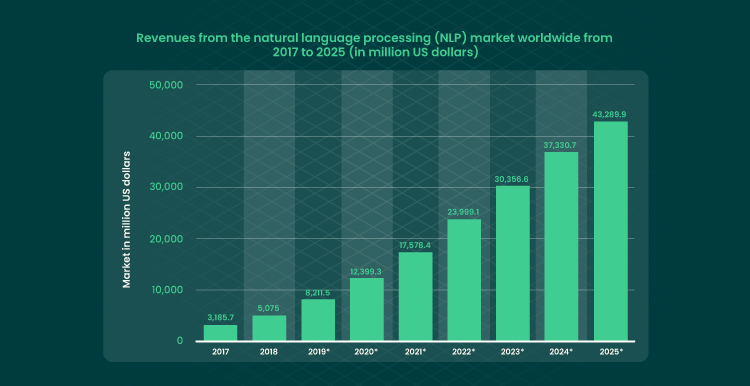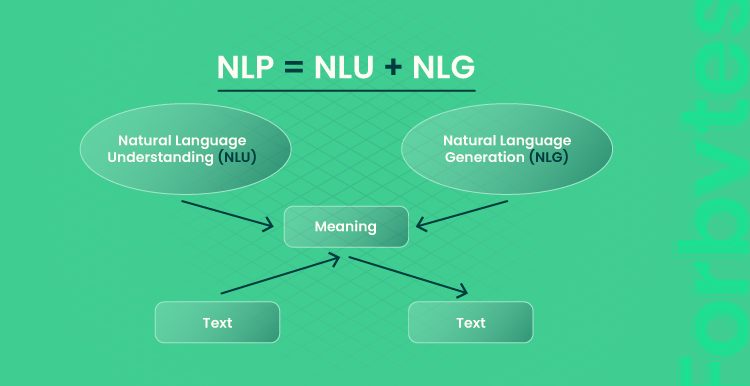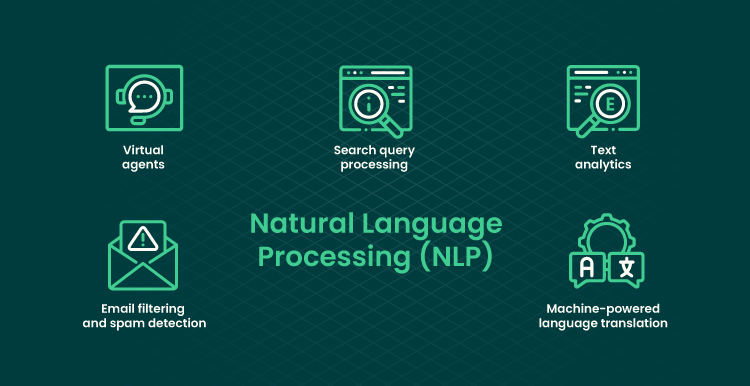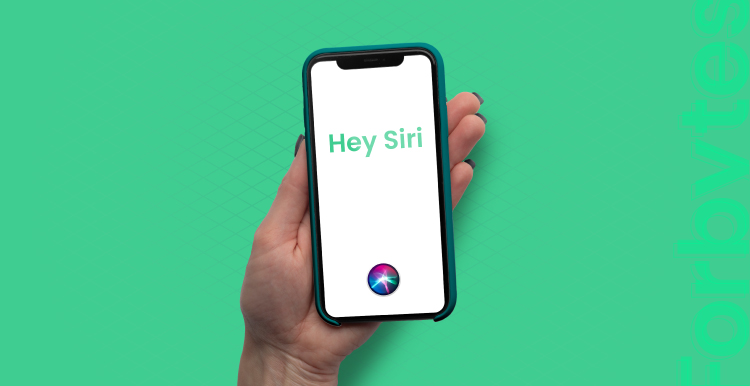Although machines are built to ease human existence, we still need to adjust to technology in one way or another. It may not be that obvious, but people started to adjust to the tech demands once the first devices ended up in human hands. We got used to texting SMS on cellular phones by pressing the same button multiply to find a needed letter. We learned to associate different notification sounds with particular action messages. But today, it’s time for machines to adjust to humans.
In this article, we’ll discuss how machines imitate human communication with the help of natural language processing and whether devices can replace humans completely. We will check out what NLP is, what tasks and challenges it deals with, and how businesses use machine learning for better results and performance.
What Is NLP?
Do you still think that the wide use of natural language processing and machine learning is a matter of tomorrow? Let’s remind you of a few cases where you may have used NLP in your daily life.
- Do you use voice assistants like Alexa, Cortana, Google Assistant, or Siri? Virtual assistants can understand your commands due to Artificial Intelligence and NLP.
- Have you ever talked with a customer service chatbot before getting in touch with the support team? These chatbots also use NLP to process your request and deliver the needed service quickly.
- Lastly, do you use spoken commands when driving a car to make a search query in your GPS app? As you may guess, this is also possible thanks to natural language processing. Let’s check what this technology is and how this area is developing today.
Natural Language Processing (NLP), is a computer science technology. It enables machines to identify and process text or speech and respond with the language output. Data scientists use it in many ways, from text extraction to the auto-correct function in mobile phones.
The AI-powered NLP applications imitate the way humans receive, interpret, and manipulate data. The following processes form the core of NLP:
- Rule-based language modeling;
- Statistics and predictive analytics;
- Machine learning;
- Deep learning models.
When put together, they allow machines to process language and generate an appropriate response. NLP application can be an internal part of business operations. It allows for effective performance and resource efficiency.
The application of NLP helps enterprises fill in the gaps in human-machine interaction. With NLP, humans use machines more naturally by applying their traditional communicative skills. The wide benefits of the NLP technology drive market growth worldwide. In 3 years, the global NLP industry is projected to grow to $43 billion. This is 14 times larger than in 2017 when the NLP market value was around $3 billion.

Major NLP Tasks
Language is not about precision. Language rules have exceptions, ambiguities, and irregularities. These may have no logical explanation and just need to be memorized. That’s why software engineers should consider language subtleties when building algorithms.
Take idioms as an example. If a person hears an idiom for the first time, they can understand its meaning intuitively. Moreover, depending on the context, an idiom may receive additional shades of meaning. One can also understand them with the help of background experience.
Unlike humans, machines have no creativity at their core; they need to be taught an idiom before interpreting it. To do it right, NLP algorithms perform a series of actions enabling the technology to deal with input and produce the output. The major tasks of NLP include:

As you see, natural language processing starts with natural language understanding. Natural language understanding (NLU), determines the meaning with the help of syntactic and semantic analysis of the text.
Natural language understanding (NLU) can include the following stages:
- Speech recognition. Speech recognition is also known as speech-to-text. This stage is inherent to apps that process voice data and voice commands. The goal of speech recognition is to recognize the voice data and convert it into a machine-readable format. The results of speech recognition depend not only on the machine’s abilities. They also depend on how clear the human speech is and under what circumstances speech recognition occurs.
- Grammatical tagging. NLP technology receives voice data and turns it into text data to work with. Then, the process of grammatical tagging starts. It’s also called speech tagging. This is when the technology identifies what part of speech the word belongs to. For instance, the word Google is represented as a noun in the sentence Google is a world-known company. and as a verb in the sentence Google this for me, please. The NLP technology analyzes the parts of speech that go after the word Google. It allows NLP to better perform grammatical or speech tagging for each particular case.
- Semantic tagging. This is matching the text data (or words) with their meaning. If the algorithm identifies a word as a single meaning, the process runs faster. But if a word has multiple meanings, syntactic tagging changes to word sense disambiguation. The latter presumes the selection of the word’s meaning based on the semantic analysis of the context. For instance, the word cry can mean speaking loudly or producing tears. Based on the context, the NLP technology chooses the right option.
Besides, the work of NLP is facilitated by the following processes:
- NEM. Named entity recognition (NEM) allows NLP technology to correlate entity names with the common notions. Entity recognition enables the technology to process the word Ann as a female name or the word US as a name of the state.
- Co-reference resolution. This process identifies the relationships between words in the text by analyzing text ontology. Humans extract the meaning of words from the contextual message. The technology applies co-reference resolution to do a similar thing. It extracts meaning from how the words are combined. So, the technology is unable to feel the context. But it can imitate this context by performing text extraction and analyzing the word combinations. For instance, the word cucumber generally means a vegetable but it loses its basic meaning in the idiom as cool as cucumber.
One more task of natural language processing is sentiment analysis. This is a more complex procedure applied for analyzing marketing results or the outcomes of targeted advertising.
- Sentiment analysis. This is the stage at which NLP algorithms analyze the connotation of the text’s message: whether it is positive, negative, or neutral. The process is used when companies need to analyze client reviews or introduce improvements to the content.
The whole process finishes with natural language generation (NLG). As you already know, natural language understanding starts with speech-to-text. Natural language generation starts with the opposite — text-to-speech. The goal of NLG is to turn the prepared output into the format of human language and deliver it to a user.
In the past, the NLG process presupposed the use of templates that were filled in by the machine on the basis of the processed data. But now, the technology has become more consistent. It involves the work of recurrent neural networks and hidden chains to deliver a more natural-like output.
NLG consists of the following stages:
- Text and sentence planning. The process starts with the overall message being formulated and logically organized. Then sentence planning starts. At this stage, the machine structures the text message into the sentence set, polishes the text flow, works on punctuation, etc.
- Language generation. Last but not least, natural language generation ends with a speech output. At this stage, all previous aspects are taken into account, such as the use of conjunctions, punctuation rules, and so on. For instance, the word’s forms are chosen according to the tense in which the text is delivered.
5 Typical Applications of Natural Language Processing
The application of NLP goes beyond Google assistant, text classification, or auto-correct function. Natural language processing is here to bring us closer to the digital world and make the use of digital products more smooth. To some extent, we may even talk about the fact that technology is becoming more human-like.
It’s amazing that modern technology can listen to us and answers our questions. A voice assistant like Siri or Alexa can cheer us up or tell us a joke when we ask for it. They know a lot about our interests and preferences and help us organize our time more effectively. This all is happening with technology now. And who knows what functions technology will be able to perform tomorrow. Still, let’s focus on what machines give us today.
Typical applications of NLP are:

Email filtering and spam detection
Email filters are the most basic application of natural language processing (NLP). The process is based on the text classification capability of NLP technology. This is the ability to classify texts based on the language they incorporate. Text classification works by detecting a particular type of language that is inherent to some category of texts.
Text classification helps to detect spam letters and phishing. But the advancement of NLP has gone even further. Apart from spam detection, the technology is used for subject-based email filtering. Let’s take the Gmail filtering algorithm as an example.
The emails in the system are classified into three main categories: primary, social, and promotions. Based on content analysis and text classification, the NLP technology sorts the letters into one of these categories. This makes it easier for a user to manage their email box, notice important and urgent letters, and provide a quick reply.
Machine-powered language translation
It’s quite a funny thing when you try to translate a sentence with the idiomatic meaning from one language to another. Machine translation applies a straight strategy, which is not the best solution in such cases. As a result, we get the output devoid of the initial meaning and intent. Such situations continue to happen today. But you may have witnessed how much machine translation has evolved in recent years.
This is not because technology learned to be creative. This is because technology learned to analyze the context and possible meaning combinations. Today, machines apply more consistent strategies for translation. They better learn from the cases when words don’t mean the things they usually mean.
NLP algorithms have also learned to identify particular sentence structures. This allows for a quality transition of meaning and tone from one language to another.
If you want to test NLP technology at work, go to Google Translate and make up some ordinary sentences. Translate a sentence from one language to another. Then translate it back to the source language and compare the original with the output you get. Check how similar the output and input are for a number of sentences. If the meaning is similar or the same, Google translate works well for this pair of languages and machine learning is well-trained.
Virtual agents
iPhone owners like chatting with Siri. Such chats are usually characterized by funny and witty answers provided by a virtual assistant. And this is one more example of NLP use.

Smart assistants like Alexa or Siri work based on natural language processing technology. Whenever you say Hey, Alexa or Hey, Siri, the technology detects the pattern and launches a voice recognition algorithm. Artificial Intelligence receives the information you said and turns voice data into text. Then, it infers meaning, generates a response, and turns the output back into the voice format.
How do such assistants know what is the best answer in each case? They also learn from the context. The more they know about you and your user habits, the better and more personalized responses they generate.
Search query processing
The technology of natural language processing is applied by search engines to gather data on user behavior. When googling something, people formulate their requests this way or another. Search queries made by a particular user are the source data for analysis by NLP. This is used for making predictions on client behavior and showing relevant search results. You might notice that search results for the same query may differ if you google the same request on your mobile phone and your laptop.
Another application of NLP in search engines is when you start typing a query and Google suggests what you may look for. That’s because Google has learned to process complex queries and encode what you mean instead of focusing on the separate words you typed in. Keyword matching techniques have become more complex as well.
Text data analytics
Natural language processing apps and solutions are used for text analysis. It may include the following:
- Predictive analytics. Autocomplete and autocorrection are examples of NLP use in predictive analytics. Not only can this technology suggest the best word options, but it also learns from you and your semantic choices. The more you use the algorithms, the better and more personalized text recommendations you get.
- Text summarization. This use case is applied when you have to review big databases of research to form a summary or detect trends or regularities. Also, the technology is applied to review customer surveys and turn survey results into applicable data. This allows the technology to detect patterns in the unstructured data and saves a lot of time for a researcher.
- Sentiment analysis. NLP technology can provide you with the results of sentiment analysis. This is very useful for understanding whether your audience likes your product. All you need to do is to give your NLP app access to data or specify what source of data has to be reviewed. The app can go through big volumes of reviews, positive or negative comments, and social media posts. This will provide you with a conclusion on the general sentiment of your client. As a result, you can perform better in targeted advertising and marketing.
- Text data structuring. This is an example of NLP techniques that other use cases fall into. NLP can turn unstructured text into the source of valuable insights and analytics. It uses machine learning analytics as well as linguistic and statistical analysis to provide a user with a meaningful output. You can take unstructured data from different sources (Google reviews, social media posts, questionnaire results) and quickly detect gaps in customer service and work on improvements.
Challenges in Processing Natural Language
You may wonder: if NLP benefits are so great, why don’t people use it everywhere? What challenges make them apply simpler technologies that cannot bring such consistent results?
Let’s answer your question by explaining why Artificial Intelligence cannot compete with humans. The answer lies in the human ability to generate creative, situational, contextual meanings. The challenges NLP tools mainly faces include:
Misspelled words and text errors
If some time ago you asked me “What is the main challenge of NLP?,” I would mention text errors. For humans, it is much easier to guess what another person meant in case of some text errors. Unlike humans, machines had to pass a long way to learn to detect common mistakes and replace them with the right variants. This enables them to process meaning and understand intention even when data has errors. As for now, this is not such an urgent challenge as it was some time ago.
Contextual meaning
The meaning of a word can change depending on the context. It may get additional positive or negative connotations the technology is not acquainted with. This is why data scientists usually don’t apply NLP to literary texts. Such texts contain lots of idioms, connotations, and other elements of figurative meaning that can be fully grasped only with human imagination.
Take sarcasm or irony as an example. These are the cases when words that denote positive or negative mean the opposite in a particular situation. Sarcasm and irony are situational, and it complicates the learning process for NLP technology. Even if you prepare vast volumes of training data, it does not guarantee that there will be two identical cases of sarcasm/irony to be learned from. Yet, the technology can learn to detect sarcasm by studying the context. For example, sarcasm and irony can be accompanied by phrases like Oh yes or Yeah right. This may help NLP algorithms to understand the meaning.
Homonyms, synonyms
Homonyms and their subtypes are words that have different meanings but are spelled identically. This poses a great challenge for machines. They need to study the context deeply to choose what meaning is implemented in each particular case. A clue to this may be the pronunciation of a speaker: we know that some of the homonyms are written the same but have different syllables stressed.
The situation gets even more complicated when it comes to synonyms. The same idea can be explained in different words in order to make the speech smoother. But machines sometimes do not get it and cannot understand that the two words are used interchangeably. But no worries: the problem can be solved by expanding the training base for natural language processing. The more training material you involve, the better deep learning models perform.
Dialects and pronunciation
Dialects that were not trained by NLP before can also pose a challenge for the right work of the technology. As a rule, dialectical words are pronounced differently or are replaced by synonyms. Sometimes such synonyms have more or fewer connotations compared to neutral words. This all creates a language barrier when it comes to working with two or more languages.
In NLP-powered translation, cultural meaning imposed on a word also affects the quality of the output. Again, the more data is trained by NLP, the better results on word meaning transition you get.
Does Your Business Need an NLP App?
In this article, we talked about natural language processing, its tasks, benefits, and challenges. But how to know if you need an NLP app for better business performance and quality results? We can conclude that NLP is good for growing businesses. If you grow steadily and it’s difficult for your employees to manage data manually, consider building an NLP app. If you need a comprehensive solution for better outcomes in targeted advertising, NLP algorithms may also help.
If you don’t plan to build an app from scratch, consider integrating the NLP algorithm into your ready-made solution. In case you need help with machine learning development or are looking for a piece of advice from ML experts, the Forbytes team is waiting for your ping.

Our Engineers
Can Help
Are you ready to discover all benefits of running a business in the digital era?

Our Engineers
Can Help
Are you ready to discover all benefits of running a business in the digital era?








